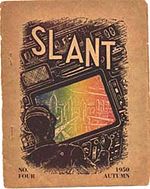Difference between revisions of "Main Page"
(updating featured article) |
(updating featured article) |
||
| Line 21: | Line 21: | ||
|style="color:#000| | |style="color:#000| | ||
| − | [[Image: | + | [[Image:Slant4-cv_copy.jpg|150px|thumb|right|linoleum-printed cover]] |
| − | ''' | + | '''Woodcut''' and '''Linocut''' are two printmaking techniques that have been used in zines. |
| − | '' | + | In a '''woodcut''' an image is carved into the surface of a block of wood, with the printing parts remaining level with the surface while the non-printing parts are removed, typically with a special chisel that has a rounded or troughlike blade that is called a gouge. The areas to show 'white' are cut away with a knife or chisel, leaving the characters or image to show in 'black' at the original surface level. The block is cut along the grain of the wood. |
| − | + | Multiple colors can be printed by keying the paper to a frame around the woodblocks (where a different block is used for each color). The woodcut can be printed on to the zine by several different ways. Firstly a roller is used to apply print ink to the woodcut. The woodcut can then be stamped on to the paper. It can also be printed onto the zine by placing the woodcut face up on a table or other surface and placing the page to be printed onto the woodcut and then rubbing on the back of the page with a spoon to ensure an even application of the page to the print ink on the wood cut. [[Woodcut_and_Linocut_in_Zine_Production|Read More...]]''' | |
| − | |||
|- | |- | ||
Revision as of 20:56, 6 January 2012
|
ZineWiki is an open-source encyclopedia devoted to zines and independent media. It covers the history, production, distribution and culture of the small press. |
| Browse by Zine Title: #-D · E-J · K-O · P-S · T-Z |
|---|
| NOTE: Before adding a project to ZineWiki, please browse the Previously Featured Articles for examples of the best ZineWiki has to offer. Keep in mind, ZineWiki is not a classifieds section, it is an encyclopedia. New entries should NOT contain simply a "sample page" and contact information. |
|---|
|
|
